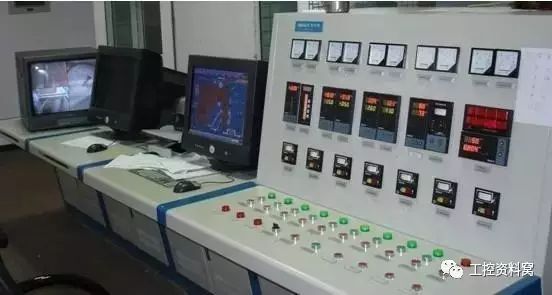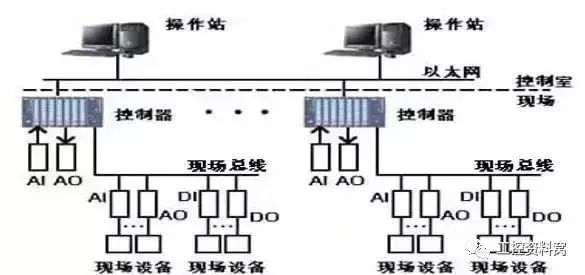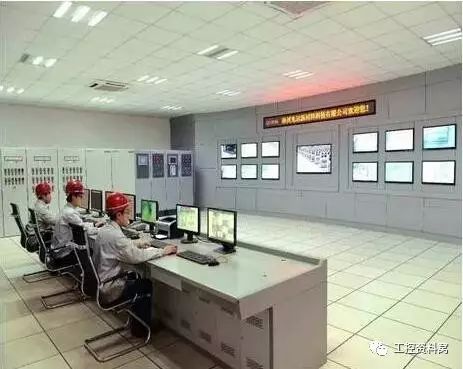Foreword
What does the DCS system mean? DCS is the acronym (Distributed Control System) of a distributed control system. It is also called a distributed control system in the domestic automation industry.
The DCS system is a multi-level computer system that is composed of a process control level and a process monitoring level and is based on a communication network, and integrates technologies such as Computer, Communication, Display (CRT), and Control.
The basic idea is
·Distributed control ·Centralized operation
·Level management · Flexible configuration
Easy to configure

The DCS system mainly consists of field control stations (I/O stations), data communication systems, human-machine interface units (operator stations OPS, engineer stations ENS), cabinets, and power supplies. The system has an open architecture and can provide multiple layers of open data interfaces.
The hardware system has a high degree of reliability, convenient maintenance, and advanced technology in the harsh industrial scene. The low-level Chinese software platform has powerful processing capabilities, and provides the ability to easily configure complex control systems and the ability of users to independently develop special advanced control algorithms; it is easy to configure and easy to use. Supports multiple fieldbus standards to accommodate future expansion needs.

Compared with conventional control instruments:
advantage:
With complete control functions, it can realize complex control and optimal control, facilitating the synthesis and analysis of information.
There is a problem:
1, dangerous concentration
2, performance problems: single load overload
3, long development cycle
Solution:
1. Choose high reliability computer
2. Introduce dualization and increase redundancy
Inscription:
As a professional who studies the control system, DCS's [system maintenance personnel responsibilities], [maintenance management], [daily inspection], [periodic inspection], [maintenance during overhaul], [fault handling], [configuration modification] And download], [system upgrade], [UPS maintenance], [instruction verification maintenance] ten areas you are professional? Xiao Bian made a detailed summary of this article. Do you want to look professional?

First, system maintenance personnel duties
1. Responsible for the system software and hardware maintenance of the DCS system to ensure the reliable operation of the DCS system and ensure the safety and stability of the production process.
2. Coordinating and participating in the DCS configuration, control program implementation, as well as the system hardware connection, operating system installation and DCS system debugging.
3. Responsible for technical communication with DCS manufacturers to learn the use, maintenance and management techniques of DCS system, give full play to the role of DCS system, and improve and perfect the control and management functions of DCS system according to the requirements of process production.
4. Instruct the operator to operate the DCS system to solve problems in the operation of the operator. Immediately after receiving the request from the operator, he responds and solves the problem.
5. Do a good job of day-to-day and regular inspection and maintenance of DCS; take the initiative to promptly identify system problems and hidden troubles, find out the causes and solve them effectively. If you encounter difficult problems that cannot be dealt with, you need to consult with the DCS vendor for coordination.
6. Responsible for system operating parameter modification and backup work to avoid any data corruption or loss events.
7. Do a good job of DCS system software and hardware backup.
8. Responsible for starting and stopping the DCS system.
9. Responsible for the setting and modification of the operator's password.
10. Formulate maintenance and management regulations for DCS systems.
Second, maintenance management guidance
1. Control Room Maintenance Management
(1) Formulate regulations for cabinet room and operation room management. The detailed regulations are stipulated on the maintenance of the sanitary environment of the cabinet room and the operation room, the management of the entry and exit personnel, the operation and management of the operator, and the maintenance and management of the maintenance personnel.
(2) In addition to maintaining proper temperature and humidity in the control room, waterproof, dustproof, anti-corrosion, anti-interference, anti-mouse pest control, and mechanical vibration prevention shall be done. For details, please refer to the "Control System Environmental Regulations" Regulations.
2. Computer (operation station, engineer station, server station) maintenance management
(1) The operator is reminded at any time to perform civilized operations, care for the equipment, keep it clean, waterproof and dustproof.
(2) The operator is forbidden to withdraw from real-time monitoring; the operator is prohibited from adding, deleting, or moving any file on the computer or changing the system configuration; the operator is prohibited from using external storage devices or optical disks.
(3) Try to avoid electromagnetic interference on the computer, avoid moving the computer, monitor, etc., to avoid pulling or bumping all kinds of connected cables.
(4) Keep the computer away from heat and ensure that the vents are not blocked by it.
(5) It is forbidden to use non-genuine operating system software (non-genuine operating system software refers to the randomly presented OEM version and other pirated software); it is forbidden to perform unnecessary multitasking operations on real-time monitoring operating platforms and run non-essential software; Forcibly shut down the computer power; it is forbidden to remove and install the computer hardware.
(6) Pay attention to the antivirus work of the computer in the operation station (engineering station) to:
Do not use removable storage devices (such as mobile hard disks, USB flash drives, etc.) that have not been effectively detoxified;
Do not connect other computers without effective antivirus on the control system network;
Do not connect the control network to other networks that are not handled with effective technology.
(7) If computer equipments such as operation stations, engineering stations, and servers need to be re-installed, they must be carried out in accordance with the "Control System Installation Procedures" provided by China Control Technology Co., Ltd.
(8) Close the computer station (operation station, engineer station, server station) cabinet doors during normal operation.
3. Control station maintenance and management
(1) Any part of the control station (main control card) is prohibited from being altered or disassembled without authorization under any circumstances.
(2) Avoid pulling or bumping the power supply, grounding, communication and signal lines during the routine inspection and modification installation.
(3) Wear an anti-static bracelet when maintaining the card.
(4) Close the control cabinet door during normal operation.
4. Backup management of system hardware and software, system configuration files, control and operating parameters
(1) The following backups must be backed up on the hard disk of this computer, and at the same time, they must be backed up on a U disk, CD-ROM, or other computer. Before the backup, you need to update the record or update the instructions:
The operator does not have permission to modify the control parameters (PID parameters, regulator positive and negative effects, etc.), control variables, process parameters and other data backup.
Configuration files such as configuration files and configuration subdirectory files (configuration files, flowchart files, control algorithm files, and report files, etc.) are backed up.
If there is any communication to a different system, the data such as the communication protocol, communication plan, and mailing address and related documents should be backed up and archived.
(2) Documents such as wiring drawings, installation drawings and other design data and handing-in materials must be archived and kept.
(3) The various software that the computer needs to install needs to be backed up on the hard disk of the local computer, such as operating system software, DCS system configuration and monitoring software, drive software, etc., make the version identification and write the installation instructions.
(4) Understand the recording period of the system, and make regular backups of production and operation records such as operation records, alarm records, and historical trends according to the requirements of process production. After marking the discs, do a good job of marking and submit them to the relevant personnel for safekeeping.
(5) To ensure the safekeeping of spare parts, it is necessary to ensure the timeliness and effectiveness of the system software and hardware spare parts (guarantee that they can be put in place during the actual operation and have good performance).
5. Maintenance precautions
(1) Do not clean with organic solvents such as alcohol when cleaning.
(2) Avoid pulling or bumping the power supply, grounding, communication, and I/O signal lines during maintenance.
(3) Lock system cabinets, instrument cabinets, and console doors to prevent non-system maintenance personnel from opening them.
Third, daily inspection guide
Daily patrol DCS system work, real-time control of DCS system operation:
1. Understand the operation of DCS to operators and solve the difficult problems of operators in time.
2. Check the DCS system fault diagnosis screen to check whether there are software and hardware faults and communication faults. Check the DCS fault diagnosis record.
3. Check the environment of the operation room and the cabinet room and the operation of the air conditioning equipment.
4. Open system cabinets, instrument cabinets, consoles, and other cabinet doors to check whether the system hardware indicators and communication indicators are abnormal.
5. Check for signs of movements such as rats and pests.
6. Make daily inspection and maintenance records.
Fourth, regular inspection guide
1. Regular inspection of DCS
After the DCS is put into operation, it should be checked regularly to ensure that the entire system can continue to work normally for a long time. Regular inspection can use the special "DCS periodic inspection record form" as the main record of DCS maintenance and use. The main contents of the inspection are as follows:
2. Control room environmental inspection
(1) Check lighting conditions, anti-jamming conditions, vibration conditions, temperature and humidity conditions, and operation conditions of air-conditioning equipment. Special attention should be paid to checking the presence of water droplets or condensation on electronic devices such as clips inside the control cabinet.
(2) Check for corrosive gas corrosion equipment and excessive dust accumulation.
(3) Conduct at least one regular inspection every week, and make regular inspection records.
3. Regular inspection of control stations and operating stations
(1) Check that the hardware of the computer, monitor, mouse, keyboard, etc. is intact;
(2) Check if the system monitors the work in real time, including data refresh, and whether the operation of each function screen is normal;
(3) Check the fault diagnosis screen to see if there is a fault prompt;
(4) To understand the DCS operation and process production situation to the operators and provide basis for the future optimization of the control plan;
(5) After the system has been running for a certain period of time, it should back up or clean up the running historical files such as historical trends and reports in a timely manner;
(6) Open system cabinets, instrument cabinets, consoles and other inspection systems for hardware failure (FAIL lights) and other abnormal conditions;
(7) Check whether the power box of each cabinet works normally, whether the power fan is working, and whether the 5V and 24V indicators are normal.
(8) Check whether the system ground (including operation station, control station, etc.) and lightning protection grounding device meet the standard requirements;
(9) Remove accumulated dust periodically to keep it clean and tidy.
(10) The above inspections are carried out at least once a week, and regular inspection records are made.
(11) When the operator station runs for a certain period of time (usually three months), use the disk consolidation program provided by the operating system to organize the hard disks C:\ and D:\.
4. Regular inspection of DCS network
(1) Check whether the indicator light of the network card of each operation station is normal;
(2) Check whether the communication indicators of all the main control cards, data forwarding cards, I/O cards, etc. are normal;
(3) Check whether the hub and switch communication lights are normal;
(4) Check whether each communication connector is reliable and normal;
(5) Check whether there is a communication failure in the "fault diagnosis" screen of the monitoring software, and whether there is a communication failure record in "diagnostic information";
(6) It is recommended that the inspection of the DCS network be conducted once every month. Check regularly to use the "troubleshooting" software.
V. Maintenance instructions during overhaul
1. During the overhaul period, the DCS system should be thoroughly maintained.
(1) Maintenance and repair of the system, including thorough dust cleaning, wiring changes, etc.
(2) Concentrate on issues that are found during routine inspections and during regular inspections that cannot be dealt with in a timely manner, such as system upgrades, configuration downloads, etc.
(3) The system should backup the DCS system configuration before overhauling, and upload and back up the system operating parameters (such as PID, etc.).
(4) To change the configuration, control and interlocking procedures during the overhaul, the responsible persons of the crafts, equipments, electrical and instrumentation must be organized to participate in the interlocking commissioning and form an interlocking commissioning record.
(5) Check whether the power supply and grounding system meet the requirements during the inspection.
(6) Make DCS maintenance records during major repairs in a timely manner.
2. System maintenance steps during overhaul
The first step: check proofread backup
Check whether the software backup, configuration file backup, control, and process data backups are correct and complete.
The second step: cut off the power in the following order
(1) After each operating station exits the real-time monitoring and operating system in turn, the operator's computer and display power supply of the operating station are turned off;
(2) Turn off the power supply box of the control station one by one;
(3) Close the power switch of each branch;
(4) Turn off the uninterruptible power supply (UPS) switch;
(5) Turn off the main power switch.
The third step: DCS power maintenance
(1) Operation station and control station power outage and maintenance. Including the internal control of the IPC, the control station cage, power box and other components of dust cleaning.
(2) Maintenance and troubleshooting should be performed for daily inspections and faults found during regular inspections that cannot be dealt with in a timely manner.
(3) Instrument and line maintenance: including power supply lines, I/O signal lines, communication lines, terminal blocks, relays, safety barriers, etc. Ensure that the instruments work properly, the lines are connected reliably, and the labels are clear and correct.
(4) Grounding system maintenance. Including terminal inspection, grounding inspection of each operation station (IPC, monitor), grounding check of each control station (power supply, cage), and resistance test to ground.
Step 4: After the maintenance work of the site and the DCS is completed, check to see if the following conditions for re-powering are met:
(1) First of all, contact the experts of process, electrical, equipment, and instrumentation to confirm whether the conditions for powering on the DCS system are satisfied.
(2) After confirming that the total power supply provided by the electric power meets the requirements, close the main circuit breaker and check the output voltage separately.
(3) Close the circuit breakers in the distribution box and check the output voltage separately.
(4) If equipped with UPS or regulated power supply, check if the output voltage of UPS or regulated power supply is normal.
Step 5: System Power Up and Test
(1) Start the engineer station, server station, operation station, and check the power box of the system in sequence.
(2) Check whether each power box is working properly, whether the power fan is working, and whether the 5V and 24V indicators are normal.
(3) Check whether the folders and files of the system software and application software of each computer are correct; there is no major change in the remaining space of the hard disk and pass the disk surface test.
(4) Compile and download the modified configuration.
(5) Observe whether there is a fault in the fault diagnosis that is monitored in real time by each operator station.
(6) Open the control station door, observe whether the card is working properly, and whether there is any fault display (FAIL lamp is on).
(7) Power Supply Redundancy Test
The redundant AC-to-220 VAC total line is opened separately, and the other AC power supply circuits lose power, but the system should still work normally.
Separately turn on the redundant DC power supply, close the other DC power supplies, and measure the voltage of 5V and 24V on the power terminal of each cage (stand).
(8) Communication redundancy test: Connect one of the communication lines of the redundant communication lines (the other communication line is disconnected) and use the download configuration function to test whether it is normal. If both of them are normal, the communication network is normal.
(9) Card redundancy test: Check whether the redundancy is normal by inserting and removing the mutually redundant card.
Note: If you dial out one of the redundant master control card and data forwarding card and plug it back in, you must wait until the data copy is completed before you can dial another redundant card. Otherwise, serious consequences will occur in the production process.
The sixth step: control, process parameter inspection
(1) Proofreading all the control and process parameters that have been successfully run (due to the configuration modification download, some parameters may appear chaotic and need to be re-entered).
(2) The replacement of control loops and newly added control loops (programs) for field instruments (transmitters, regulators, etc.) require re-tuning and commissioning.
16+ Years Experience Smart Watch manufacturer, ITOPNOO Provide One-stop Smart Wearable devices Solutions For You.
Our Smart Wearable products include android smart watches, Watch For iPhone, Bracelet and Wristband etc.
Leading healthcare navigation services for individuals and families who are generally healthy or face serious medical issues, and health services for employers.
The Trends New Watches Designs. Custom smart watch products designed with the vision of our clients' brands in mind.
Wholesale smart watches,Best Smart Watches,Gifts Wholesalers, smart watch manufacturer
TOPNOTCH INTERNATIONAL GROUP LIMITED , https://www.micbluetooth.com